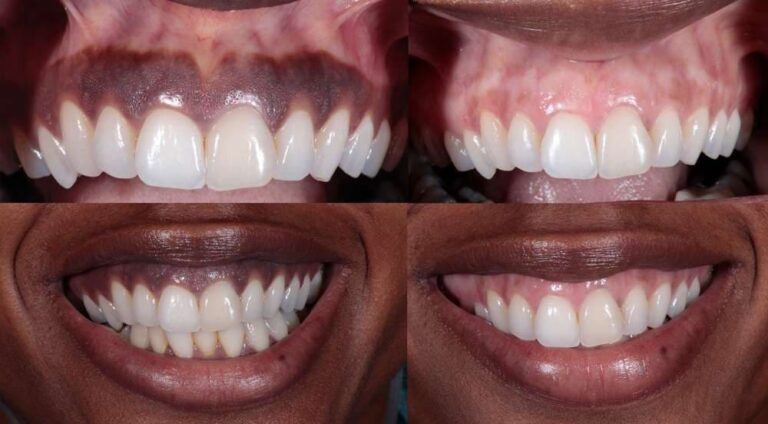
UM DEPIGMENTATION & BLEACHING
When you imagine a dazzling, healthy-smile, usually the first thing that comes to mind are shiny, white teeth. But healthy gums are essential, if not the most important part of a beautiful smile. A healthy smile consists of gum tissue that is naturally pink in color, fits tightly around the teeth without periodontal pockets, does not cover the teeth with excessive gum tissue creating a what is known as a gummy smile, and has not deteriorated, often time as a result of periodontal disease, meaning the gums have not worn away as is the case with gum recession.
Gum pigmentation is not a cause for medical concern, and is therefore considered a cosmetic procedure done to improve the aesthetics of one’s smile. For many, dark gums can affect their self confidence, and hinder their self-esteem when speaking and smiling.
Gum depigmentation, also known as gum bleaching, is a cosmetic periodontal procedure used to remove dark spots on the gums. Normal, healthy gum tissue will typically appear pale pink in color. However, in the case of gum depigmentation, abnormally high amounts of melanin can cause dark spots and patches to appear on the tissue. This discoloration can affect the appearance of your smile and result in decreased confidence and self-esteem for many men and women.
Gum depigmentation, commonly known as gum lightening or gum bleaching, does not actually utilize any sort of bleach or lightening agent to achieve lighter gums. The term draws on the idea of teeth whitening and bleaching, which imply a treatment or product used to lighten the teeth. However bleaching solutions and agents are not safe for application on the gums. Our center utilize advanced technology coupled with cutting-edge techniques to perform various periodontal treatments in Los Angeles to restore their patients’ oral health and help them smile confidently again. A gum depigmentation procedure can be performed using several techniques, and successfully removes the dark spots on the gums caused by excess melanin. The treatment results in healthy looking gum tissue, and will reveal a more attractive smile that will have you showing off your full beautiful smile with excitement!
HOW TO KNOW WHEN YOU HAVE DARK GUMS
Typically, healthy gums should appear pale pink in color. However, people with darker complections may experience a brown shade on their gums, due to their natural extra melanin production. Some people are born with darker gums, as it is a genetic component, while others may experience changes in gum tissue color as a result of varying factors. Because these changes may be indicative of prominent underlying issues, it is imperative to be aware of changes in gum tissue color, and see a periodontist if you notice changes in color. Changes can include dark spots, brown spots, or patches.
GUMMY SMILE TREATMENTS CAN GIVE YOU A STUNNING SMILE
If you’re familiar with the term gummy smile or may have a gummy smile yourself, you understand one of the most frustrating things about a gummy smile is that it can make you feel self-conscious when smiling. If you’re not familiar with gummy smiles, it describes the condition where the upper teeth appear too short due to excessive gum tissue covering the teeth. Thanks to advanced treatments now available to remove excess gum tissue, we can resolve the issue through minimally invasive procedures such as aesthetic crown lengthening or non-surgical lip repositioning, enabling patients to smile again with confidence. One of the reasons why many patients turn to periodontists is to increase the aesthetics of their smiles. If you feel less confident about your gummy-looking smile, too, read more below about how we can detect and fix it.
LOTS OF PEOPLE HAVE BIG GUMS AND SMALL TEETH
According to statistics, about 10 – 15% of all people on earth have a so-called gingival smile or a gummy smile with prominent gums and a small amount of teeth showing. What does it look like? It’s usually a smile in which you can see more than two millimeters of the upper gum. Exposure with a smile less than two millimeters of the upper gum is normal. The ideal option is a smile in which the gums are not visible at all, and only the upper incisors are exposed, while the lower front teeth are either not visible at all or are seen quite a bit.
WHAT CAUSES A GUMMY SMILE?
Several things can cause a gummy smile, from the early growth and development of your jaw bone to tooth eruption and its effect on the appearance of your gums to some of these other common causes of a gummy smile:
Abnormal eruption of your teeth: We often see patients with a gummy smile caused by an abnormal eruption of their permanent teeth after losing their baby teeth which allowed excessive gum tissues to develop around the new adult permanent teeth, making them appear shorter than they are, causing a gummy smile.
The muscle of your upper lip is overactive or hyperactive: Some people have a hyperactive upper lip where the muscles responsible for controlling the skin below the nose can cause your lip to rise farther than usual and exposing too much of your gums, creating the appearance of a gummier smile.
Vertical maxillary excess (VME): How your jaw grew and developed can impact how your smile looks. Typically an overgrowth of the upper jaw, called vertical maxillary excess (VME), makes gums bulge out, creating a gummy smile.
Altered passive eruption (APE): APE’s altered passive eruption is caused mainly by genetic or developmental factors that create excessive soft tissue over the tooth’s surface, creating a gummy smile.
Microdontia (Small Teeth): Teeth that are small compared to the gums due to genetics or wear will create an excessive gingival display.
HOW TO FIX A GUMMY SMILE
Whether you have too much gum tissue or the natural positioning of your lips reveals too much of your upper gums, there are several common treatments to help you fix your gummy smile, which we will discuss more below. Depending on your specific needs, the treatment options will vary
WHAT IS THE BEST TREATMENT FOR A GUMMY SMILE?
A smile with gums is often a purely aesthetic problem that does not affect the health of the teeth and does not depend on it. However, it’s better to schedule a consultation to understand what causes your gums to be more visible. When you find out the reasons, the doctor will suggest the appropriate method of excessive gum tissue correction, and you will be able to choose the time for treatment. Our Doctors experts in the treatment options used to improve the smile line and fix a gummy smile.
Depending on how much gum tissue each patient has and their specific needs, we may suggest one of the following appropriate treatment options such as:
Aesthetic crown lengthening
Surgical lip repositioning
Non-surgical lip repositioning (Botox)
Lip enhancement
FIX YOUR GUMMY SMILE WITH AESTHETIC CROWN LENGTHENING
A beautiful smile is often attributed to straight, white teeth. But truthfully, a picture perfect smile begins with healthy gums. A gummy smile occurs simply when a patient smiles and too much gum tissue is exposed. For many patients, they are born with an excess amount of gum tissue that covers their tooth roots, causing their teeth to appear much shorter than they actually are. Although the underlying teeth may be healthy, it is hidden beneath the gum tissue, which causes a child-like appearance of the teeth.
AESTHETIC CROWN LENGTHENING PROCEDURE
Aesthetic crown lengthening is a surgical procedure that can be used to improve a gummy smile. A gummy smile is caused by excessive gum tissue which covers the teeth creating a short and child-like appearance. This cutting-edge periodontal technique involves removing the excess gum tissue, and re-contouring the gum line to expose more of the natural tooth, creating a fuller, more attractive smile. When preparing for dental restorations in the case of functional crown lengthening, the underlying bone may be modified to allow your periodontist to place a permanent restoration such as a crown.
Aesthetic Crown lengthening is normally performed under local anesthetic and IV sedation. The duration of the procedure will depend on how many teeth are being treated and whether any amount of bone needs to be removed along with the soft tissue. Once the periodontist achieves an aesthetically pleasing crown length, the treated area is cleaned and restored to an ideal appearance. Doctors perform aesthetic crown lengthening to provide their patients with a natural looking, fuller smile.
